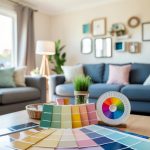How to Style Your Living Room Like a Pro: Essential Tips and Tricks
Styling a living room like a professional can transform your space into a harmonious blend of aesthetic appeal and functional design. By starting from the ground up and ensuring every piece has a purpose, we can create a room that feels both inviting and sophisticated. The foundation often begins with a rug, which anchors the space and sets the tone for the rest of the decor.
To bring our living room to life, we focus on defining a clear focal point, such as a striking fireplace, an eye-catching piece of art, or a standout piece of furniture. This focal point acts as the centerpiece around which everything else is arranged, creating visual interest and cohesion. Additionally, incorporating personal touches, like unique decor items or family photos, ensures the space reflects our individual style.
A well-designed living room balances color and lighting to achieve the desired mood. By using a mix of soft, ambient lighting and strategically placed accent lights, we can highlight key areas while maintaining a warm, welcoming atmosphere. Thoughtfully selected colors enhance this effect, bringing the entire design together into a unified, elegant space.
Understanding Living Room Layouts
Achieving a professional look in your living room involves careful consideration of the layout, flow, and functionality. By strategically planning zones, optimizing every square foot, and selecting versatile furniture, we can create a space that is both stylish and efficient.
Importance of Flow and Zones
Creating a smooth flow and distinct zones is essential for a functional living room. We should begin by understanding the natural pathways within the room. Positioning the largest piece of furniture, usually the sofa, against a wall or centering it around a focal point like a fireplace can help define the main area.
By designating clear zones for different activities such as lounging, reading, or entertaining, we bring order and usability to the space. For instance, a reading corner can be a quiet nook with an armchair and a small side table.
Optimizing for Square Footage
Optimizing square footage ensures every inch of space is utilized effectively. In smaller living rooms, it is crucial to avoid overcrowding. We can achieve this by choosing appropriately sized furniture and considering vertical space for storage.
Built-in shelves or floating shelves can provide storage and display areas without taking up floor space. For larger rooms, arranging furniture in such a way that there are multiple seating areas can prevent the space from feeling cavernous. Using area rugs to separate different zones can also be very effective.
Selecting Multi-Functional Furniture
Choosing multi-functional furniture adds versatility to the living room. Pieces like ottomans with storage, fold-out sofa beds, or nesting tables can serve multiple purposes, making them ideal for both small and large living spaces.
We should look for furniture that can adapt to different needs, such as expandable dining tables or modular sofas. This flexibility ensures the room can be easily rearranged for various occasions, from a casual family gathering to a formal dinner party.
By focusing on flow, maximizing the use of square footage, and selecting adaptable furniture, we can create a living room that is both stylish and functional, embodying the principles of professional interior design.
Developing Your Design Vision
To style your living room like a pro, it’s crucial to first develop a clear design vision. This step forms the foundation for all other choices, including colors, furniture, and décor elements. We’ll discuss how to find inspiration, create a cohesive color palette, and integrate your personal style.
Finding Inspiration
Finding inspiration is the first step in developing your design vision. We can start by looking through various platforms like Pinterest, home décor magazines, and interior design blogs. These resources offer a plethora of ideas and can help us identify what styles resonate with us. When we see a particular room or element we like, we should save it to create a visual collection of our preferences.
We can also visit showrooms or even friends’ homes to see design ideas in person. Furthermore, paying attention to our daily environments—like cafes, restaurants, or hotels—can give us new and unique ideas. Different textures, layouts, and styles can spark creativity and guide us toward defining what we really want in our living room.


